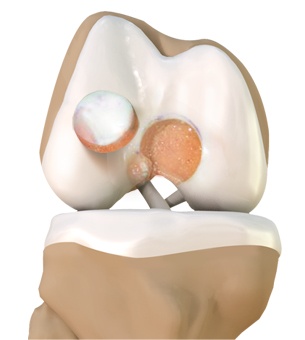Cartilage Restoration

Articular cartilage is the smooth, shiny, white tissue covering the ends of bones which form a joint. Articular cartilage reduces friction when bones glide over each other, making the movements smooth and painless. It also acts as a shock absorber to help prevent traumatic injuries to the bones. When cartilage is damaged it can cause painful movements and limited joint mobility and eventually progress to osteoarthritis.
Cartilage damage can occur from normal wear and tear of the body’s joints as we age as well as from injury or other disease conditions. Because of its avascular nature (absence of blood supply), cartilage cannot repair itself and therefore surgical treatment is usually required to restore cartilage function and prevent progression of the damage into arthritis.
Causes
Articular cartilage may be damaged by accidental falls, sports injuries or progressive degeneration (wear and tear). It is possible for cartilage cells to heal, but it depends on the extent of the damage and location of injury. However, the healing capacity is minimal owing to the lack of blood supply. Therefore, often times your surgeon will discuss with you different surgical cartilage repair/restoration options. These procedures are indicated only if you have a focal cartilage defect, not arthritis (diffuse cartilage loss).
Diagnosis
Your surgeon will perform a physical examination to look for altered range of motion, swelling, and bone alignment. Often, your surgeon will obtain X-rays and an MRI to evaluate the size, location, and depth of the defect. You may be required to obtain a full-length x-ray to evaluate your bony alignment.
Surgical Treatment
Young adults with cartilage injury are ideal candidates for cartilage restoration surgery because these methods help prevent the progression of damage into osteoarthritis.
The most common joint requiring cartilage restoration is the knee joint and other joints include the shoulder and ankle joints.
Damaged cartilage can be treated by two different techniques – repair and regeneration. Repair technique involves replacing damaged cartilage with new cells and extracellular matrix that stimulates healing of the injured cartilage.Regeneration involves replacing the injured cartilage with a new articulating surface that functionally simulates the growth of original cartilage.
Surgery is often not recommended in smaller cartilage defects. Defects smaller than 2 cm can be treated arthroscopically and have a good prognosis. Larger defects may require cartilage transplantation.
Surgical Treatment
Most cartilage restoration procedures can be performed arthroscopically, a minimally invasive surgery using arthroscope, a small flexible tube with a light and video camera at the end that enables to view inside the joints and perform surgery.
During arthroscopy a few small puncture incisions are made around the joint. In certain cases, open surgery may be required to access the affected area requiring longer incisions. Your surgeon will discuss the best surgical options for your child’s particular condition.
The surgical procedures for cartilage restoration include:
- Microfracture
- Osteochondral Autograft Transfer
- Osteochondral Allograft Transplantation
- Matrix-Induced Autologous Chondrocyte Implantation (MACI)
- Joint Unloading Osteotomies
After the completion of surgery, you will be advised to practice certain post-operative care measures to ensure better outcomes. They include:
Suture care: A dressing will be placed over the sutures and you will be instructed on when it can be removed (usually after 3 days). You may apply ice over the dressing for 20 minutes every hour to decrease swelling and pain.
Exercises: Physical therapy is usually started within 1-2 weeks of surgery to help restore motion to the affected joint.
Activity restrictions: Your surgeon will give you activity restrictions to follow during the healing process depending on which joint is involved.
Risks and Complications
As with any surgery, cartilage restoration is associated with certain risks and complications. Graft delamination – Detachment of the grafts from the subchondral bone and the surrounding cartilage. Allergic response, transfer of disease and infection, and graft rejection in allograft transplants Injury to healthy cartilage
Some of the risks related to any orthopaedic surgery can include:
- Post-operative bleeding
- Deep vein thrombosis
- Infection
- Stiffness of the joint
- Numbness around the incisions
- Injury to vessels or nerves






